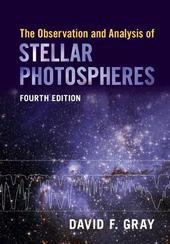
|
The Observation and Analysis of Stellar Photospheres
Paperback / softback
Main Details
| Title |
The Observation and Analysis of Stellar Photospheres
|
| Authors and Contributors |
By (author) David F. Gray
|
| Physical Properties |
| Format:Paperback / softback | | Pages:550 | | Dimensions(mm): Height 244,Width 169 |
|
| Category/Genre | Observatories, equipment and methods |
|---|
| ISBN/Barcode |
9781009078016
|
| Classifications | Dewey:523.82 |
|---|
| Audience | | Tertiary Education (US: College) | | Professional & Vocational | |
|---|
| Edition |
4th Revised edition
|
| Illustrations |
Worked examples or Exercises
|
|
Publishing Details |
| Publisher |
Cambridge University Press
|
| Imprint |
Cambridge University Press
|
| Publication Date |
16 December 2021 |
| Publication Country |
United Kingdom
|
Description
This textbook describes the equipment, observational techniques, and analysis used in the investigation of stellar photospheres. Now in its fourth edition, the text has been thoroughly updated and revised to be more accessible to students. New figures have been added to illustrate key concepts, while diagrams have been redrawn and refreshed throughout. The book starts by developing the tools of analysis, and then demonstrates how they can be applied. Topics covered include radiation transfer, models of stellar photospheres, spectroscopic equipment, how to observe stellar spectra, and techniques for measuring stellar temperatures, radii, surface gravities, chemical composition, velocity fields, and rotation rates. Up-to-date results for real stars are included. Written for starting graduate students or advanced undergraduates, this textbook also includes a wealth of reference material useful to researchers. eBook formats include color imagery while print formats are greyscale only; a wide selection of the color images are available online.
Author Biography
David F. Gray is a Professor Emeritus of Astronomy at Western University, London, Ontario, Canada, where he has held positions since 1966. He was president of IAU Commission 36, on the Theory of Stellar Atmospheres 1988-1991, and served on the observing-time allocation panels of the Hubble Space Telescope and the Canada-France-Hawaii telescope. He is a member of the Canadian Astronomical Society, the International Astronomical Union, Sigma Xi Honorary Society, and the American Astronomical Society, and has served on numerous organizing committees for astronomical symposia. He was an invited lecturer at the Canary Islands Winter School of Astrophysics, the Catania Observatory, and the Beijing Observatory.
Reviews'Gray's newest edition has made several key improvements that will render it an important book not only for stellar atmospheres and evolution courses, but also for courses involving modern instrumentation techniques or for anyone working in the field of exoplanets. Each chapter is clearly and logically laid out and extensively referenced, including exercises to support scaffolded learning throughout the undergraduate and graduate curriculum; this makes the book an easy choice for professors teaching both introductory and upper level courses. Gray's new book is destined to become an essential companion for every professional astronomer whose research is impacted by observational effects and the inner workings of stellar photospheres.' Prof. Michelle J. Creech-Eakman, New Mexico Tech 'Gray's textbook has been a staple for my teaching and research for the past two decades. The close connection the book makes between theory and observation has always distinguished it and made it particularly valuable. The addition of new topics and results, and the inclusion of many of the more recent, seminal references make the new edition particularly valuable for students and researchers entering the field of stellar astrophysics.' Prof. Christopher M. Johns-Krull, Rice University 'David Gray's book puts the decades of the author's hands-on experience, combined with his scientific ingenuity, into a form that students and young researcher love. Clearly, David Gray's book has evolved. The Fourth Edition is not just a graduate student's textbook, it is now also an up-to-date window into practical stellar astrophysical research. As in the past, all my graduate students will get it as their bible.' Prof. Klaus G. Strassmeier, University of Potsdam, and Leibniz Institute for Astrophysics, Germany
|